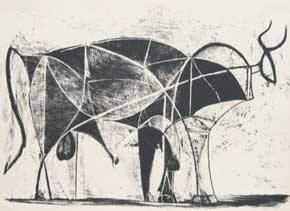
Pablo Picasso
The Bull, state VII (Le Taureau)
December 26, 1945
Lithograph. Composition 12 x 17 1/2″ (30.5 x 44.4 cm). Sheet 12 15/16 x 17 1/2″ (32 x 44.4 cm)
The Museum of Modern Art. Mrs. Gilbert W. Chapman Fund
© 2009 Estate of Pablo Picasso/Artists Rights Society (ARS), New York
MOMA presents ‘Picasso: Themes and Variations’
The Museum of Modern Art presents Picasso: Themes and Variations, an exhibition exploring Pablo Picasso’s creative process through the medium of printmaking, from March 28 to August 30, 2010. It features approximately 100 works from the Museum’s superlative collection of the artist’s prints. The exhibition is organized by Deborah Wye, The Abby Aldrich Rockefeller Chief Curator of Prints and Illustrated Books, The Museum of Modern Art.
]]>
Source: MOMA
Pablo Picasso’s insatiable curiosity and tireless urge to create art often led him to mediums beyond painting. He fully explored sculpture and drawing, as well as printmaking and ceramics. This exhibition looks at Picasso’s engagement with printmaking over the course of his long career, and the ways it fostered his creativity by encouraging a thematic approach to his subjects and by allowing for constant experimentation.
As a young artist, Picasso (Spanish, 1881–1973) bought a small printing press, and prints became part of the ongoing development of his work. His first series of etchings and drypoints was devoted to themes of the Blue and Rose periods. Examples include Frugal Repast (1904), a well-known scene of a destitute couple at a sparsely-filled dining table. Others depict itinerant circus performers known as saltimbanques. As Picasso went on to forge his Cubist style, he made prints intermittently, cross-fertilizing related drawings and paintings. One series of his abstracted images was conceived in 1910 to illustrate St. Matorel, a book by poet Max Jacob, who was among his closest friends during the first years in Paris.
While prints played a small but continuing role in Picasso’s early work, by the late 1920s and early 1930s, he became truly engaged in the medium, and remained so for the rest of his life. It was at that time that he grasped the narrative potential in his printmaking. He enjoyed propping up his copperplates and conjuring up compositions that led his invented characters from one scene to another. Later he would call this manner of printmaking his own way of “writing fiction.”
Picasso created tales of the Minotaur, of fauns and satyrs, and of bullfighting. In Minotauromachy (1935), he combined the Minotaur myth and the violence of the bullfight in a highly symbolic, enigmatic scene that is considered a milestone of modern printmaking. Especially under the influence of Surrealism, such motifs became entangled with events inPicasso’s personal life, particularly those involving his relationships with women. These entanglements are also a factor in other themes he explored, from scenes of the artist in the studio, to portrayals of sexual aggression, to tableaux in which one figure watches the other sleep
Follow us on:


